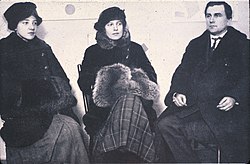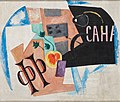| Olga Rozanova | |
|---|---|
 Rozanova in 1900 Rozanova in 1900 | |
| Born | Olga Vladimirovna Rozanova (1886-07-22)22 July 1886 Melenki, near Vladimir Oblast, Russia |
| Died | 7 November 1918(1918-11-07) (aged 32) Moscow, Russia |
| Movement | Cubo-Futurism, Suprematism |
| External videos | |
|---|---|
 | |
Olga Vladimirovna Rozanova (also spelled Rosanova, Russian: Ольга Владимировна Розанова) (22 June 1886 – 7 November 1918, Moscow) was a Russian avant-garde artist painting in the styles of Suprematism, Neo-Primitivism, and Cubo-Futurism.
Biography

Early life
Olga Rozanova was born in Melenki, a small town near Vladimir. Her father, Vladimir Rozanov, was a district police officer and her mother, Elizaveta Rozanova, was the daughter of an Orthodox priest. She was the family's fifth child; she had two sisters, Anna and Alevtina, and two brothers, Anatolii and Vladimir. Rozanova's father died in 1903, and her mother became the head of the household.
She graduated from the Vladimir Women's Gymnasium in 1904. Due to her interest in the avant-garde movement, she moved to Moscow to study painting.
Artistic career

After arriving in Moscow, she attended the Bolshakov Art School, where she worked under Nikolai Ulyanov and sculptor Andrey Matveev. She audited courses at the Stroganov School of Applied Art in 1907 but was not accepted for admission. After this, she trained in the private studio of Konstantin Yuon. From 1907 to 1910, fellow drawing and painting students studying in these private studios included Lyubov Popova, Nadezhda Udaltsova, Aleksei Kruchenykh, and Serge Charchoune. Unlike most of the other female avant-garde artists, Rozanova was the only one who did not study abroad to learn about European art.
By 1910, she was fairly well-known in Russian art circles. She moved to St. Petersburg and joined Soyuz Molodyozhi (Union of Youth) in 1911. She became one of the most active members of this organization, which organized art exhibitions, lectures, and discussions. Two of her canvases, Nature-morte and The Café debuted at the second Soyuz Molodyozhi exhibition in April 1911. She would submit her canvases to their group exhibitions until 1913. Razanova briefly studied at the art school of Elizabeta Zvantseva, which housed many Russian Art Nouveau artists. In January 1912, her two works, Portrait and Still-Life, appeared at the next Soyuz Molodyozhi exhibition in January 1912. This exhibition was the first appearance of the Donkey's Tail, a Moscow-based artistic group led by Mikhail Larionov. Rozanova later traveled to Moscow to try to establish joint projects between the two groups; these negotiations proved to be unsuccessful. Soyuz Molodyozhi disbanded in 1914.
From 1913 to 1914, Cubo-Futurist ideas appeared in her work, but she appears to have been especially inspired by Futurism. Of all the Russian Cubo-Futurists, Rozanova's work most closely upholds the ideals of Italian Futurism. During Filippo Tommaso Marinetti's visit to Russia in 1914, he was very impressed with her work. Rozanova later exhibited four works in the First Free International Futurist Exhibition in Rome, which took place from 13 April to 25 May 1914. Other Russian artists featured in the exhibition included Alexander Archipenko, Nikolai Kulbin, and Aleksandra Ekster.
She met the poet Aleksei Kruchenykh in 1912; he then introduced her to the Russian Futurist concept of zaum (translated as "beyonsence") poetry, a language with no fixed meanings and constant neologisms, which is probably used by birds. Rozanova would write her own poetry in that style, and also illustrated books of zaum poetry, two examples being A Little Duck's Nest of Bad Words and Explodity (both 1913). With Kruchenykh, she would invent a new kind of Futurist book, the samopismo, where the illustrations and the text would be literally connected.

Rozanova joined the avant-garde group Supremus that year, which was led by former fellow Cubo-Futurist Kazimir Malevich. By this time, her paintings have developed from the influences of Cubism and Futurism, and took an original departure into pure abstraction, where the composition is organized by the visual weight and relationship of color.
In the same year she exhibited at the 0,10 Exhibition, and, together with other Suprematist artists (Kazimir Malevich, Aleksandra Ekster, Nina Genke, Liubov Popova, Ksenia Boguslavskaya, Nadezhda Udaltsova, Ivan Kliun, Ivan Puni and others) worked at the Verbovka Village Folk Centre.
From 1917 to 1918 she created a series of non-objective paintings which she called tsv'etopis'. Her Non-objective composition, 1918 also known as Green stripe anticipates the flat picture plane and poetic nuancing of color of some Abstract Expressionists.
Rozanova also published literary works, which included the essay The Bases of the New Creation and the Reasons Why it is Misunderstood. This was written in response to critics of modern art and held that the world is a raw material - that it is the back of a mirror for the unreceptive soul and a mirror of images for the reflective soul. She maintained that the creation of pictures based on the "Abstract Principle" constitute three stages: the intuitive principle; the individual transformation of the visible; and, abstract creation. In her criticism of photography, Rozanova agreed with Oscar Wilde that photography is for the "servile artist".
Death and legacy
She died of diphtheria at the age of 32 in Moscow in 1918, following a cold she contracted while working on preparations for the first anniversary of the October Revolution.
Her work is in the collections of the Museum of Modern Art, the Philadelphia Museum of Art, the Thyssen-Bornemisza Museum, and the Carnegie Museum of Art,
Rozanova's work was included in the 2021 exhibition Women in Abstraction at the Centre Pompidou.
Major works
- In a Cafe (c.1911-1912) - One of Rozanova's earlier pieces, In a Café, depicts a man and a woman on opposing sides of a table, the man with his head in his hand and the women with a drink in hers. Rozanova makes use of vibrant colors and thick lines to create a piece with aspects of French avant-garde and Russian Neo-Primitivistic art.
- The Factory and the Bridge (c. 1913) - The Factory and the Bridge was included in the First Free International Futurist Exhibition in 1914. This piece had inspiration from the Italian Futurism movement, and its bright colors gives it an expressionist tone.
- Metronome (c. 1914) - A piece from the middle of her career, Metronome was displayed at the Last Futurist Exhibition 0,10 in Petrograd in 1915.
- Playing Cards series (1915) - One of her most famous works, the series represents the height of her artistic career. It consists of portraits of her peers set as designs for playing cards.
Gallery
-
 Female Portrait (1907)
Female Portrait (1907)
-
 Jug with Flowers (1911-1912)
Jug with Flowers (1911-1912)
-
 Dissonance (1913)
Dissonance (1913)
-
 Factory and Bridge (1913)
Factory and Bridge (1913)
-
 Cityscape (1914)
Cityscape (1914)
-
 Third Colour Composition (all 1914)
Third Colour Composition (all 1914)
-
 Still-Life (Futurist Composition) (1915)
Still-Life (Futurist Composition) (1915)
-
 Watches and Cards (1915)
Watches and Cards (1915)
-
 Automobile (1915)
Automobile (1915)
-
 Suprematism (1916)
Suprematism (1916)
-
 Non-Objective Composition (1917)
Non-Objective Composition (1917)
-
 Green Stripe (1917)
Green Stripe (1917)
-
 Non-Objective Composition (1917)
Non-Objective Composition (1917)
-
 Hand Fan - Design for Verbovka (1917)
Hand Fan - Design for Verbovka (1917)
References
- Olga Rozanova. MoMA 2013. Retrieved 6 May 2013.
- Amazons of the avant-garde : Alexandra Exter [and others]. Bowlt, John E., Drutt, Matthew., Deutsche Guggenheim Berlin. New York: Guggenheim Museum. 2000. ISBN 0892072253. OCLC 43879449.
{{cite book}}: CS1 maint: others (link) - ^ Perloff, Nancy (2017). Explodity: Sound, Image, and Word in Russian Futurist Book Art. Getty Publications. p. 115. ISBN 978-1-60606-508-2.
- Gurianova, Nina (6 December 2012). Olga Rozanova and the Early Russian Avant-Garde 1910-1918. New York: Taylor and Francis. p. 135.
- "Olga Rozanova Biography, Life & Quotes". The Art Story. Retrieved 2020-03-10.
- ^ Sarabianov, Andrei D. "Olga Rozanova". Encyclopedia Britannica. Retrieved 28 May 2020.
- Gurianova, Nina (6 December 2012). Olga Rozanova and the Early Russian Avant-Garde 1910-1918. New York: Taylor and Francis. p. 6.
- ^ Tedman, Gary (2012). Aesthetics & Alienation. John Hunt Publishing. ISBN 978-1-78099-302-7.
- Gurianova, Nina (6 December 2012). Olga Rozanova and the Early Russian Avant-Garde 1910-1918. New York: Taylor and Francis. p. 140.
- Gurianova, Nina (6 December 2012). Olga Rozanova and the Early Russian Avant-Garde 1910-1918. New York: Taylor and Francis. p. 152.
- ^ "Olga Rozanova Biography – Olga Rozanova on artnet". www.artnet.com. Retrieved 2020-03-10.
- Gurianova, Nina (2012). Exploring Color: Olga Rozanova and the Early Russian Avant-Garde 1910-1918. New York, NY: Routledge. p. 187. ISBN 978-905701192-4.
- ^ Altintzoglou, Euripides (2018). Portraiture and Critical Reflections on Being. New York: Routledge. ISBN 978-0-429-01670-7.
- Stepanova, Vavara (1919). Biograpficheskaia zametka o Rozanovoi. Moscow: Rodchenko and Stepanova Archive.
- "Olga Rozanova". Museum of Modern Art. Retrieved 22 July 2024.
- "Olga Vladimirova Rozanova". Philadelphia Museum of Art. Retrieved 22 July 2024.
- "Rozanova, Olga". Museo Nacional Thyssen-Bornemisza. Retrieved 22 July 2024.
- "Olga Rozanova". Carnegie Museum of Art. Retrieved 22 July 2024.
- Women in abstraction. London : New York, New York: Thames & Hudson Ltd. ; Thames & Hudson Inc. 2021. p. 170. ISBN 978-0500094372.
- "Olga Rozanova Artworks & Famous Paintings". The Art Story. Retrieved 2020-03-10.
- "Olga Rozanova Paintings, Bio, Ideas". The Art Story. Retrieved 2020-03-10.
Sources
- Russian avant-garde, Andrei Nakov, Art Data, 1986
- Abstract Art, Mel Gooding, Tate Publishing, 2001
- "Shishanov V.A. Vitebsk Museum of Modern Art history of creation and collection. 1918–1941. – Minsk: Medisont, 2007. – 144 p. (in Russian) Russian Books Catalog. Vitebskii muzei sovremennogo iskusstva : istoriia sozdaniia i kollektsii, (1918--1941), Visual Arts, Belarus, Минск, Belarus, Russian,
Further reading
- Olga Rozanova Paintings, Bio, Ideas
- Tedman, Gary. Soviet Avant Garde Aesthetics, chapter from Aesthetics & Alienation. pp 203–229. Zero Books. 2012. ISBN 978-1-78099-301-0
- Gur'yanova,Nina. Ol'ga Rozanova i rannii russkii avangard (Olga Rozanova and early Russian avant garde. 318 pp. Gileya, Moscow, 2002 (ISBN 9785879870213)
External links
- 50 pictures of art-works by Olga Rozanova, on Wikiart
- Olga Vladimirovna Rozanov biography at the Wayback Machine (archived May 13, 2008)
- 1886 births
- 1918 deaths
- 20th-century Russian painters
- Russian avant-garde
- Russian women painters
- Russian watercolorists
- Ukrainian women painters
- Suprematism (art movement)
- 20th-century Russian women artists
- Women watercolorists
- Infectious disease deaths in Russia
- Respiratory disease deaths in Russia
- Deaths from diphtheria
- Painters from the Russian Empire
- 20th-century women painters